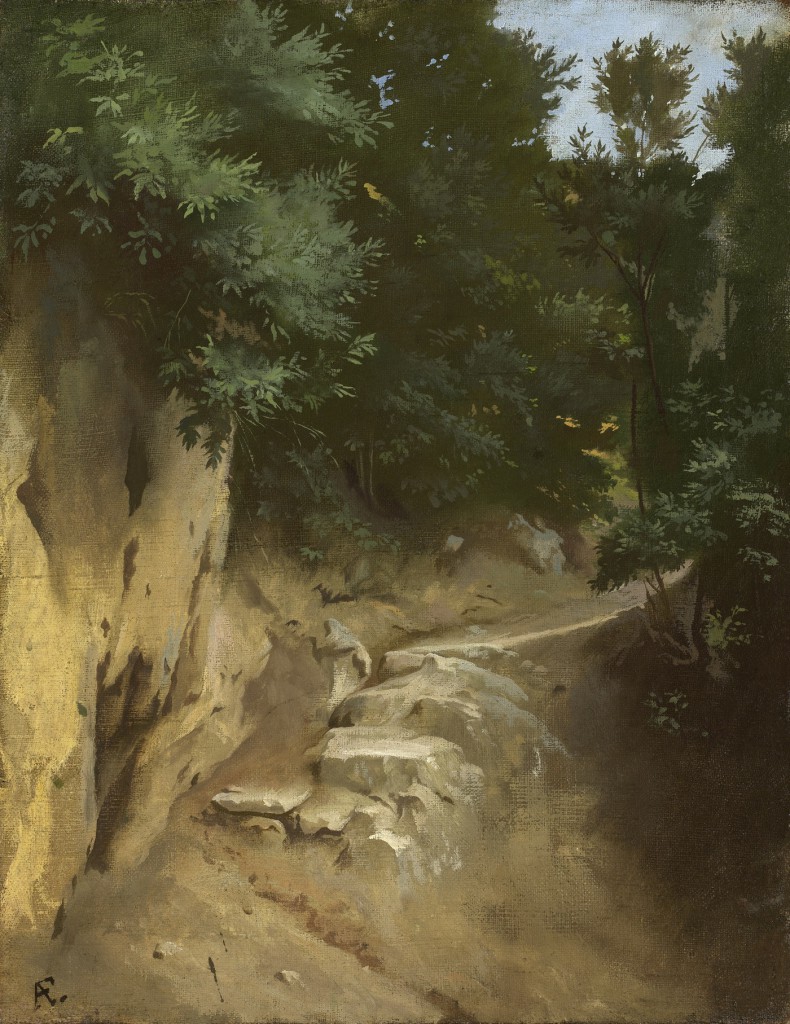Anselm Feuerbach
(Speyer 1829 - 1880 Venice)
Narrow Path in the Campagna Romana, c.1860-2
Oil on canvas, 47 x 36 cm
Signed with the initials at the lower left AF (in ligature)
Provenance:
Rudolf Probst, Das Kunsthaus, Mannheim, 19421;
Private collection, Switzerland.
Literature:
Weltkunst, 16/37-8, 12 September 1942, repr. p.4 (advertising Rudolf Probst's Kunsthaus in Mannheim);
Jürgen Ecker, Anselm Feuerbach. Leben und Werk. Kritischer Katalog der Gemälde, Ölskizzen und Ölstudien, catalogue raisonné, Munich 1991, no. 292.
We are grateful to Dr. Jürgen Ecker for his assistance in researching the provenance and dating of this study.
This very fine study depicts a steep, narrow path partly overhung by vegetation in a rocky hillside. Feuerbach would have seen many similar paths hewn into the rock on his excursions into the countryside of the Campagna Romana. The painting focuses on the contrast between the areas of shade with their soft, flowing contours and clearly defined, light-infused patches of stone, earth and vegetation.
The Feuerbach expert Jürgen Ecker suggests that the study is dateable to the late 1850s on the basis of the characteristics of the monogram. Similar autographic traits are to be found in other works of the period.2 However he points out that a date of execution in the early 1860s is not implausible on stylistic grounds.
The fluid, very free manner of execution with its focus on light and atmospheric effect is a style Feuerbach adopted during his sojourn in Paris between 1851 and 1854.3 Overwhelmed by the collections in the Louvre, he sought inspiration in the work of the Old Masters. Before long, he turned to the work of contemporary French artists - Eugène Delacroix, Gustave Courbet and the painters of the Barbizon School. Not only was the experience of their work to have a formative influence on his painting but his contacts with the painter Thomas Couture (1815-79), whose studio he shared for a time, were of key importance in his later career. His indebtedness to the art of Couture is apparent in the new freedom and fluidity of his brushwork.4 Couture's influence is also apparent in the compositional breadth and monumentality of Feuerbach's handling of the subject, combined with use of soft tonal gradations and subtle colouristic refinement. All these elements are clearly evident in the present study. Feuerbach wrote in a letter to his mother: Couture's figures possess the sculptural nobility and beauty of the antique. My eyes are being opened daily to what dear Father [Feuerbach's father was an archaeology professor] always wanted despite his sufferings, and even though I was late in realizing it, the knowledge of it will be with me all my life.5
1 See Anja Walter-Ris, Die Geschichte der Galerie Nierendorf, Diss., FU Berlin 2003, note 31: '[Dr. Herbert Tannenbaum] ... founded a gallery named 'Das Kunsthaus' in Mannheim in 1920. From 1933 onwards, he found himself increasingly subjected to anti-Semitic attacks. In November 1936 he sold the gallery to a colleague, Rudolf Probst (1890-1968). A victim of Nazi repression, Probst had been forced to close his own gallery, Galerie Neue Kunst Fides, in Dresden in 1934, and was optimistic that he could resume his gallery activities at new premises in Mannheim. This he managed to do by pursuing a 'less extreme' programme - until the Kunsthaus was destroyed by bombing in 1943. Tannenbaum emigrated with his family to Holland in May 1937. Miraculously, they survived German occupation unharmed. ... After the war, the family moved to New York and in 1949 Tannenbaum set up a new gallery on 57th Street, ...' See Karl-Ludwig Hofmann, Christmut Präger and Kathrin von Welck (eds.), Für die Kunst! Herbert Tannenbaum und sein Kunsthaus. Ein Galerist - seine Künstler, seine Kunden, sein Konzept, exhib. cat., Mannheim, Reiß-Museum der Stadt Mannheim, 1994.
2 Characteristic traits of the 'AF' ligature on other Feuerbach works of the period are the rather pronounced downstroke on the 'F' and the left slant of the ligature.
3 [Coutures Gestalten haben eine solche plastische Noblesse und Schönheit wie die Antiken. Mir geht ein Licht über dem anderen auf, was der liebe Vater trotz seiner Leiden immer wollte, und wenn ich auch spät zur Erkenntnis gelangte, so ist die Erfahrung für mein ganzes Leben]. Feuerbach interrupted his visit several times. He was in Paris from May 1851 to the summer of 1852, from November 1852 to May 1853 and from October 1853 to April 1854.
4 Feuerbach would have witnessed Couture, and possibly Courbet, using a painting knife or a palette knife.
5 Guido Joseph Kern and Hermann Uhde-Bernays (eds.), Anselm Feuerbachs Briefe an seine Mutter, I, Berlin 1911, p. 299.

